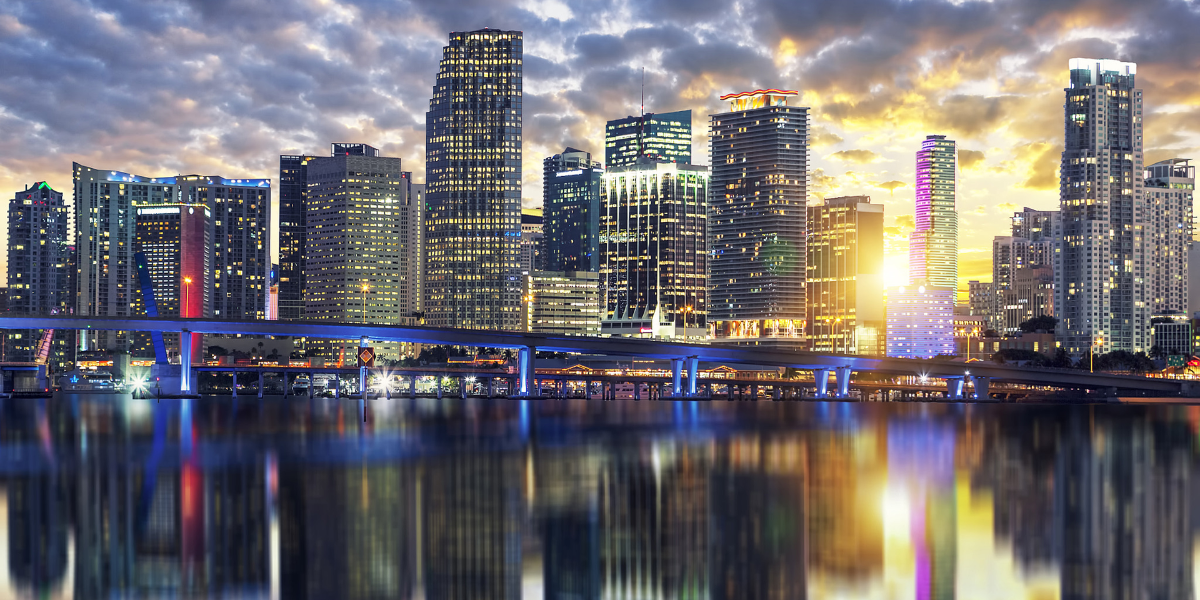The “Sunshine State,” as Florida is commonly known, is a unique mosaic of landscapes and cultures that welcomes tourists from all over the world. No matter what draws you to Florida—its beautiful beaches, fascinating wildlife, or rich cultural history—you’re sure to find something to captivate you. Discover all that Florida has to offer with this all-inclusive guide.
Location has played a pivotal role in Florida’s rich history and vibrant present, and it also serves to explain the state’s remarkable personality. A peninsula juts out from the North American continent to the southeast, forming the bulk of Florida.
This peninsula divides the Atlantic Ocean from the Gulf of Mexico and points southeast toward Cuba and the Caribbean Sea. Just two states—Georgia to the east and Alabama to the west—share a land border with Florida, and both are located near its northern frontier.
Approximately 50 miles (80 km) east of the state’s southern point is the Bahamian island of Bimini, the closest foreign territory. There are 48 contiguous states in the United States, with Florida being the most southern. The northernmost point of Florida is located around 100 miles (160 km) south of the southern border of California.
A crescent of islands that makes up the southernmost part of the state, the Florida Keys, stretches all the way to the Tropic of Cancer, which is about 75 miles (120 km) away. The length of Florida’s marine shoreline exceeds 8,400 miles (13,500 km), with approximately 5,100 miles (8,200 km) extending along the gulf. The only U.S. state with a longer coastline is Alaska.

Recent News about Florida:
This state is strategically located near the geographic and demographic centers of the Western Hemisphere. It also has a commanding view of one entrance to the Gulf of Mexico and a crossroads between North and South America as well as historic routes to the Mediterranean and Europe.
La Florida, which translates as “The Flower” in Spanish, was claimed by Spain after Spanish explorer Juan Ponce de León landed there in 1513. In the long-ago wars between European nations over who would rule the Americas and the Caribbean, Florida was a pivotal player. Located on the northeastern coast of Florida, St. Augustine was established in 1565 and is considered the oldest European town inside the territory that would later be occupied by the United States.
People from all over the world go to the “Sunshine State” to enjoy its beautiful weather and breathtaking landscapes. While the state’s economy has shifted away from agriculture and manufacturing and toward tourism, many immigrants, primarily from Latin America, have been lured to Florida by the promise of employment in the state’s fast expanding service sector.
Consequently, Florida’s immigrant population has been steadily rising, placing it among the top states in this regard. Total area: 65,757 square miles or 170,311 square kilometers. Current population: 21,538,187 in 2020; estimated 22,610,726 in 2023.
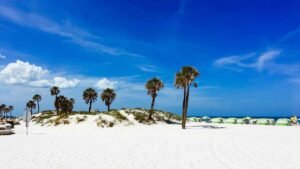
Land Relief:
Most of Florida lies at an elevation of less than 100 feet (30 meters) above sea level, making it a relatively new, low-lying plain. Located in Walton County, close to the Alabama border, the highest point is just 345 feet (105 meters) above sea level. The majority of the state is covered by sand and limestone sediments, with regions of peat and muck indicating the sites of former bodies of freshwater.
Modern topography is mostly the result of natural processes such as erosion of limestone rocks by water, waves, ocean currents, winds, and variations in sea level. Although these divisions are barely visible to the naked eye, these forces have caused enough variation in the state’s surface to establish seven basic physiographic regions: the coastal lowlands, the Lake Okeechobee-Everglades basin, the Kissimmee lowlands, the Marianna lowlands, the central highlands, the Tallahassee hills, and the western highlands.
The coastal lowlands stretch for over three quarters of the landmass and range in breadth from sixteen hundred kilometers (16 km) to one hundred miles (24 km). Typically, the area is rather level and hardly rises more than a few feet (8 meters) above sea level.
There are a lot of swamps here, and in the state’s eastern half, you may see a series of parallel beaches. Nearly all of Florida’s most beautiful beaches are located on offshore barrier bars.
Though they are technically subsets of the coastal lowlands, the Kissimmee lowlands and the Lake Okeechobee-Everglades basin warrant distinct names due to their distinctive features. In actuality, the former is a shallow, slowly-moving river (the Everglades is commonly referred to as a “river of grass”) that is 150 miles (240 km) long and 50 miles (80 km) broad.
The main zone for sugarcane production in Florida is located in the northern part, which has been altered by canals, dikes, and pumping stations. Everglades National Park protects the southern half, which has maintained most of its pre-European character. The Kissimmee lowlands encompass the expansive valley of the Kissimmee River, the primary conduit for water that flows southward to Lake Okeechobee.
These lowlands are approximately the same size as the Lake Okeechobee-Everglades basin. The majority of this area is covered in flat grasslands where cattle ranches and pastures grow.
A little area in the northwest panhandle, the Marianna lowlands are bordered to the east by the Apalachicola River and to the west by the Choctawhatchee River. There are a lot of sinkholes and caverns because the area is very degraded.
In the east, you’ll find the Tallahassee hills; in the west, you’ll find the highlands that go all the way to the Alabama border, divided by the Marianna plains. These two areas are roughly the same size, spanning 65 by 160 kilometers (40 by 100 miles), and they are both formed from ancient highland plains that have been carved away by streams. Their combined beauty and gentle rolling hills make this region of Florida ideal for growing farm crops.
On the eastern side of the Tallahassee hills is where you’ll find the Suwannee River, and the central highlands are located between there and the coastal lowlands to the east, where you’ll find the St. Johns River.
The region stretches almost 400 miles (640 km) south of the Georgia border to the Arcadia and Sebring areas; its width is from 80 to 120 km, and it varies in length from 50 to 75 miles (80 to 120 km). Most of Florida’s citrus acreage is located in the middle and southern parts of the peninsula, which is characterized by rolling terrain and dotted with thousands of lakes.
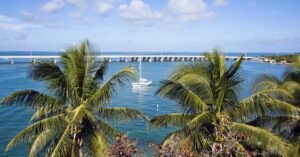
Climate:
The fact that the entire state of Florida is within a few miles of the water helps to moderate the weather a bit. Regions south of Lake Okeechobee, including the Florida Keys, experience a genuine tropical climate, in contrast to the humid subtropical climate that prevails north of the lake. Late July typically sees high temperatures in the mid 90s Fahrenheit, which is equivalent to 32-34 °C. From north Florida, where the average low is in the low 40s (4-7 °C) in early to mid-January, the south of the state has temperatures above 60 °F (16 °C). It is the hottest U.S. state, with daily average temperatures of 70.7 °F (21.5 °C).
Summertime highs in the state rarely get above 100 degrees Fahrenheit (37.8 degrees Celsius). Record lows have been recorded in the 10s (-12 to -7 °C), while multiple coldest maximum have occurred in the 30s °F (-1 to 4 °C). Typically, these temperatures in northern and central Florida don’t last more than a few days. Cold weather is uncommon in South Florida.[80] The It was in Monticello on June 29, 1931, that the state of Florida recorded its highest temperature of 109 °F, or 43 °C. Tallahassee, located about 25 miles (40 km) away, recorded the coldest temperature of -2 °F (-19 °C) on February 13, 1899.
Little to no snow falls in Florida every year because of the state’s tropical and subtropical environment. Pensacola, Gainesville, and Jacksonville are among the farthest northern places that can occasionally get snowfall due to a mix of cold precipitation and freezing temperatures. Occasionally, the panhandle will have frost, a more frequent occurrence than snow. Zone 8a in the inland western panhandle has temperatures no lower than 10 °F or -12 °C, while zone 11b in the southern Florida Keys has temperatures no lower than 45 °F or 7 °C, according to the USDA plant hardiness zones for the state. The No matter where you are in Florida, you can expect to see fog.
The “Sunshine State” moniker belies the frequency with which catastrophic weather strikes Florida. Because of its disproportionately high lightning strike frequency, central Florida has earned the nickname “lightning capital” of the US. Because afternoon thunderstorms are widespread throughout much of Florida from late spring until early October, the Sunshine State has one of the highest average precipitation levels of any state. Between 2,400 and 2,800 hours of sunshine per year are received by a limited eastern portion of the state, which includes Orlando and Jacksonville. Annually, the remaining portions of the state, including Miami, receive 2,800 to 3,200 hours.
Tornadoes in Florida are more common than in the Midwest and Great Plains, but they rarely approach the intensity levels seen in other regions. The strongest thunderstorms are frequently accompanied with hail.
Every year from June 1st to November 30th, especially in the months of August and October, hurricanes present a significant risk. There is a long stretch of coastline in Florida that is either subtropical or tropical, making it the state most vulnerable to hurricanes. Florida and Texas have been impacted by 83% of the U.S. storms of a category of 4 or higher.
The Sunshine State was hit by 114 storms between 1851 and 2006, with 37 of those storms being major (category 3 and higher). Tropical storms almost always make landfall in the state during hurricane season.
Hurricane Andrew, which made landfall in Florida in August 1992 and caused damages of over $25 billion, was the costliest weather disaster in U.S. history at the time. It remained in that position until Hurricane Katrina in 2005 overtook it, and six other hurricanes have since surpassed it. Hurricane Andrew ranks second in terms of damage to Florida’s economy.
Education:
Education Week’s 2020 Quality Counts survey ranks Florida as the third best US state for K-12 education in 2020, with the Sunshine State surpassing the national average in fifteen out of eighteen measures. The state received a “B−” score, which is lower than the national average of C, on the K-12 Achievement scale, which evaluates growth in areas including academic performance and graduation rates. U.S. News & World Report placed Florida’s K-12 system 27th best in the country, and the state’s university system first.
Primary and secondary education:
As of 2018, 2,833,115 students were enrolled in 4,269 public primary, secondary, and vocational schools throughout 67 regular or seven special school districts in Florida. The state’s educational system is comprised of both public and independent private institutions. With almost 350,000 pupils, Miami-Dade County holds the title for largest of Florida’s 67 regular districts, while Jefferson County ranks last with fewer than 1,000 students. In 2016, Florida’s per-student spending was $8,920, ranking it 43rd in the United States.
School districts in Florida are overseen by the Florida Department of Education. Each county has its own system of school districts. Policy, funding, objectives, and expenditures are all decided by the elected Board of Education of each school district. A superintendent of schools is responsible for management.
By law, the state of Florida must provide its teachers with ESOL (English as a Second Language) training.
Karla Hernández, a teacher and president of United Teachers of Dade, claims that the DeSantis administration’s policies will exacerbate the problem of over 5,000 vacant teaching positions in Florida’s public schools. The state of Florida was experiencing “really scary moments,” she said, citing the stalling of an AP African American studies course, book bans, and the removal of certain lessons.
A public school curriculum in Florida was endorsed in 2023 by the state’s conservative advocacy group Prager. The videos compared people who doubt climate change to those who opposed Communism and Nazism, implied that renewable energy was bad for the environment, and stated that global warming happens naturally. “Leftwing stuff” is what DeSantis has dubbed climate change.
In order to adhere to state law, Florida teachers have restricted the teaching of Shakespearean plays and literature starting in August 2023.
Higher education:
The Florida Board of Governors oversees the State University System of Florida, which was established in 1905. Three hundred forty-six thousand four hundred and sixty-four students enrolled at one of these twelve colleges in 2019. Tuition for four-year programs in Florida was $26,000 for in-state students and $86,000 for out-of-state students in 2016, ranking it second lowest in the US. The national average for in-state students was $34,800.
In 2020, three Florida institutions—Orlando’s University of Central Florida (ranked #2), Gainesville’s University of Florida (ranked #4), and Miami’s Florida International University (ranked #8)—were among the top ten biggest universities in the US according to enrollment.
There are 68 campuses that make up the Florida College System, which includes 28 public community and state schools. More than 813 thousand students enrolled in 2016.
Thirty private schools in Florida make up the Independent Colleges and Universities of Florida. More than 158,000 students were served in the autumn of 2020 by member institutions of this Association.
Among the best private research universities in the country is the Coral Gables-based University of Miami. Founded in 1883, Stetson institution in DeLand was the first private institution in Florida.
The University of South Florida, the University of Miami, and the University of Florida are the three Florida institutions that will be members of the Association of American Universities in 2023.
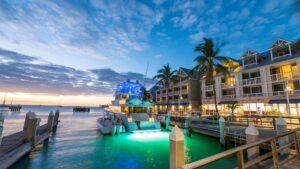
Traveling Places in Florida:
1. Miami Beach: Known for its glamorous nightlife, stunning Art Deco architecture, and beautiful beaches, Miami Beach is a must-visit destination in Florida.
2. Everglades National Park: A UNESCO World Heritage Site, the Everglades is home to unique ecosystems, alligators, and diverse bird species. Airboat tours offer a thrilling way to explore this natural wonder.
3. Key West: Located at the southernmost point of the continental United States, Key West is famous for its laid-back atmosphere, historic sites like Ernest Hemingway’s house, and vibrant sunsets.
4. Orlando: The theme park capital of the world, Orlando boasts Walt Disney World Resort, Universal Studios, and SeaWorld, making it a top destination for families and thrill-seekers alike.
5. St. Augustine: As the oldest city in the U.S., St. Augustine is steeped in history. Visitors can explore Castillo de San Marcos, a 17th-century fortress, and stroll along cobblestone streets lined with colonial architecture.
Public transportation:
- As for public transportation in Miami, the city’s heavy rail rapid transit system, Metrorail, as well as the people mover train system in Downtown Miami, Metromover, and the bus system, are all operated by Miami-Dade Transit. With two lines and twenty-three stops, Metrorail serves all of Miami-Dade County and links to Metromover and Tri-Rail in Downtown Miami. In Downtown Miami, you can catch the Metromover at any of its 21 stops along its three lines. Tri-train provides intercounty commuter train service, with 18 stations including the region’s three international airports; outside of Miami-Dade County, Broward County Transit and Palm Tran operate public transit in the Miami metropolitan area.
- At present, there are four stops along the 32-mile (51-kilometer) (61-mile, or 98-kilometer) SunRail commuter rail line that serves Orlando. More specifically, the Orange, Seminole, and Osceola counties around Orlando are serviced by the Lynx bus.
- Use the Hillsborough Area Regional Transit Authority system (“HART”) if you’re in or around Tampa. On top of that, the Tampa Electric Company powers a historic trolley that provides continuous trolley service in downtown Tampa. Through the Pinellas Suncoast Transit Authority (PSTA) system, St. Petersburg and Pinellas County offer comparable services. A continuous trolley bus also serves Pinellas County’s beaches. There is a trolley system in downtown St. Petersburg.
- The Jacksonville Skyway is an automated people mover monorail that links several areas in Jacksonville, including the downtown campus of Florida State College, the Northbank core business district, the Convention Center, and Southbank. Two lines link eight stops in the system. There are a total of 180 buses on the JTA’s 56 lines.

History of Florida:
Florida’s varied landscapes reflect the state’s rich past. The Seminole and Calusa were among the original peoples who lived in what is now Florida before the Spanish colonized the area in the 1600s.
It went through a number of ownership changes before finally becoming a U.S. territory in 1821 and a state in 1845. After Florida’s secession from the Union during the Civil War, the state was readmitted. The late 19th-century entrance of railroads and the rise of tourism as a significant industry sped up the expansion of the state.
European arrival:
The first area in what is now the contiguous United States that Europeans visited and colonized was Florida. Juan Ponce de León brought with him the first recorded European explorers. On April 2, 1513, Ponce de León saw the peninsula and made landfall. In honor of the lush, flowery surroundings and the fact that it was Easter, or Pascua Florida (Festival of Flowers) to the Spanish, he named it La Florida. They landed the next day in order to obtain information and claim this new territory. The legend that he was looking for the Fountain of Youth only surfaced many years after his passing.
Hernando de Soto skirted the Florida coast in May 1539 in quest of a deep harbor where he might land. Mile after mile, he described a dense wall of red mangroves, some as high as 70 feet (21 meters), with entwined and raised roots that made landing challenging.
Christianity, sheep, horses, cattle, the Castilian language, and other things were brought to Florida by the Spanish. With varied degrees of success, Spain founded various towns in Florida. Don Tristán de Luna y Arellano founded one of the earliest towns in Florida in 1559 at the location of modern-day Pensacola, but by 1561 it had largely fallen into disuse.
The Spanish destroyed the French settlement at Fort Caroline, in what is now Duval County, in 1564–1565. A rebuilt replica of the fort now sits where it once stood in Jacksonville.
Under the governor and admiral Pedro Menéndez de Avilés’s direction, the settlement of St. Augustine (San Agustín) was founded in 1565, giving rise to the first Floridanos and the Florida government, as well as the oldest continuously occupied European settlement in the continental United States.
Spain converted the native tribes to Christianity in order to retain strategic dominance over the area. Luisa de Abrego, a free Black domestic worker from Seville, married white Segovian Miguel Rodríguez at St. Augustine in 1565. In the continental United States, it is the earliest known Christian marriage.
Some Spanish married or united with Pensacola, Creek, or African women, both free and enslaved; their progeny produced a mestizo and mulatto population. Slaves from the Thirteen Colonies were enticed to Florida by the Spanish, who offered freedom in return for their conversion to Catholicism.
A royal decree was issued by Spain’s King Charles II liberating all slaves who escaped to Spanish Florida and consented to baptism and conversion. The majority of runaway slaves ended themselves around St. Augustine, but some made it as far as Pensacola. As early as 1683, St. Augustine had organized an all-black militia regiment to defend Spanish Florida.
As English settlements were established to the north and French claims were established to the west, the geographical area of Spanish claims in La Florida shrank. Throughout the 17th and 18th centuries, English colonists and buccaneers repeatedly attacked St. Augustine, destroying both the city and its cathedral. Spain constructed Fort Matanzas in 1742 and Castillo de San Marcos in 1672 to protect the capital of Florida from invasions and to hold its advantageous location in the defense of the Spanish West Indies and the Captaincy General of Cuba.
The first free black settlement to be officially recognized in North America was Fort Gracia Real de Santa Teresa de Mose, near St. Augustine, which was founded in 1738 by Manuel de Montiano, the Spanish governor of Florida. Montiano granted citizenship and freedom to escaped slaves in exchange for their participation in the Florida militia.
Spain gave the Kingdom of Great Britain Florida in exchange for Havana, Cuba, which the British had taken during the Seven Years’ War. As part of the 1763 Treaty of Paris, which put an end to the Seven Years’ War, the commerce was conducted.
France lost Florida and gave Louisiana to Spain as compensation. Much of the remaining Indigenous population in Florida was taken to Cuba by the vast majority of the departing Floridian population.[25] The King’s Road, which connects St. Augustine to Georgia, was built by the British quite quickly.
Once known as “Cow Ford” by the British due to the fact that cattle were taken across the river there, the route spanned the St. Johns River at a narrow spot called Wacca Pilatka, which is now the center of Downtown Jacksonville.
The Florida provinces (Las Floridas) were split and merged by the British into East Florida and West Florida; the Spanish government maintained this separation following the short British occupation. To promote settlement, the British government awarded land concessions to officers and soldiers who had participated in the French and Indian War. Reports about the natural abundance of Florida were disseminated in England to entice settlers to relocate there. Many “energetic and of good character” British settlers, primarily from South Carolina, Georgia, and England, made the trip to Florida.
A party of settlers from the Bermudan colony was also present. In what are now Duval, Baker, St. Johns, and Nassau counties, this was the first permanent English-speaking population. The British built well-maintained public roads, brought in fruit, sugar cane, and indigo farming, and started exporting lumber.
In order to create laws for the Floridas, the British governors were instructed to convene general assemblies as soon as feasible. In the interim, they were also instructed to set up tribunals based on council recommendations.
This marked the beginning of Florida’s English-derived legal system, which includes county-based government, habeas corpus, and jury trials. To compose the Declaration of Independence, representatives from neither East Florida nor West Florida traveled to Philadelphia. Florida stayed a stronghold of the Loyalists throughout the American Revolution.
Following Britain’s defeat in the Revolutionary War and the following 1783 Treaty of Versailles, Spain reclaimed both East and West Florida and maintained the provincial divisions until 1821.

Cities and towns:
With a population of almost 6.06 million, the Miami-Dade County metropolitan area is the biggest in both the state and the entire Southeast United States. Next in line with over 3.02 million people is the Tampa Bay area; over 2.44 million people call the Orlando metropolitan area home; and over 1.47 million call the Jacksonville metropolitan area home.
According to the US Office of Management and Budget (OMB), there are 22 MSAs in Florida. There is an MSA in 43 of Florida’s 67 counties.
“Municipality” is the official name for any town, city, or hamlet in Florida. Towns, villages, and cities all have the same legal status in the Sunshine State.
In 2000, 89% of Floridians lived in urban areas, compared to 79% nationally; this demonstrates the state’s high level of urbanization. The text
Nearly three-quarters of the inhabitants resided within ten miles (16 km) of the shore in 2012.
Population:
With a 14.24% growth from the 2010 US census, the Florida population was projected by the U.S. Census Bureau at 21,477,737 on July 1, 2019 is a At the time of the 2010 census, 18,801,310 people called Florida home. The 154th When looking at the twelve months ending July 1, 2012, Florida ranked as the seventh fastest-growing state in the US.
he Between Frost proof and Fort Meade was where the majority of Floridians lived in 2010. Since the 1960 census, Polk County has been home to the center of population, which has only shifted slightly to the east, less than 5 miles (8 km) and around 1 mile (1.6 km) north, between 1980 and 2010.
As of December 2014, the population had surpassed 19.7 million, putting Florida ahead of New York for the first time and making it the third most populous state in the US. According to the 2019 Population Estimates Program of the United States Census Bureau, 21,477,737 individuals called Florida home. The number 159 Its population grew to 21,538,187 at the 2020 census.
A total of 1,269,765 people (6.9% of the population) identified as having exclusively American ancestry in 2010.171 and 172 A large portion of this group has “American” ancestry or does not know their true family tree because their English or Scotch-Irish ancestors have lived in the state for generations.174, 175, 176, 177, and 178 Among the 2,232,514 Floridians who self-reported as having English or predominantly English American ancestry in the 1980 US census, the largest ancestry group was English. They traced some of their family tree back to the first thirteen colonies.
The percentage of Floridians descended from Europeans (i.e., those without Hispanic origin) was 57.9% in 2010. The top five ethnic groupings comprising 57.9% were as follows: 12.0% German (2,212,391), 10.7% Irish (1,979,058), 8.8% English (1,629,832), 6.6% Italian (1,215,242), 2.8% Polish (511,229), and 2.7% French (504,641). The All corners of the state are populated by white Americans of various European origins. Nearly 80% of Floridians were non-Hispanic white in 1970.
Every major city and suburban area in the state is home to a sizable population descended from English and Irish immigrants. As a self-deprecating epithet, “Florida crackers” may be used by certain native white Floridians, particularly those who have long-established Florida ancestry, while others find it insulting. Their ancestry primarily comes from English and Scots-Irish settlers, along with other British Americans, just like whites in the majority of southern states.
About 22.5% (4,223,806) of Floridians might be considered to have Hispanic or Latino ancestry in 2010. The largest groupings among the 22.5% were the Cubans (6.5%, 1,213,438) and the Puerto Ricans (4.5%). Cuban Americans make up sizable populations in Tampa and Miami, Puerto Ricans in Orlando and Tampa, and migrant laborers from Mexico and Central America make up sizable populations in the state of Florida. Hispanics are becoming increasingly mobile and well-off.
The Hispanic community in Florida is vast and varied, with the biggest concentrations being Cubans and Puerto Ricans. A large and prosperous Cuban community in South Florida is home to over 80% of Cuban Americans. After New York, Florida is home to the nation’s second-largest and fastest-growing Puerto Rican community. Puerto Ricans make up a larger percentage of Florida overall, with the largest percentages concentrated in the Central Florida region around Orlando.
The South Florida region surrounding Miami and, to a lesser extent, Central Florida, are home to some of the most diversified and largest Hispanic/Latino communities in the United States. Most Latino groups have sizeable populations in the state, including the dominating Cuban and Puerto Rican communities as well as considerable populations of Mexicans, Colombians, Venezuelans, and Dominicans, among many more.
In 2010, 16.0% of Floridians were of African descent; this number includes African Americans. Among the 16.0%, 4,0 percent (741,879) identified as Afro-Caribbean or West Indian. Almost half of the state’s population in the early 1900s was Black. The In the Great Migration, which began in 1910 and continued in waves until 1940 and again beginning in the late 1940s, many African Americans left Florida for northern cities in reaction to segregation, disenfranchisement, and the agricultural crisis. They migrated in search of employment, new educational opportunities for their children, and the right to vote and hold public office.
The state’s African American population had dropped to 18% by 1960.The number 186 Whites from the north, on the other hand, flocked to the state in great numbers. There are still sizable Black communities spread out across Florida. Many Black people in the Miami/South Florida area may trace their ancestry back to African slaves who came to the United States. However, there are also many Black people who are of West Indian, recent African, or Afro-Latino immigrant backgrounds. The Haitian Americans make up the biggest single group of West Indians in Florida, who hail from a wide variety of Caribbean countries.
Among U.S. citizens, 4.5% were of West Indian descent in 2016, with 2.3% (483,874) having Haitian, 1.5% (303,527) Jamaican, and 0.2% (31,966) Bahamian heritage, among various West Indian ethnicities comprising the remainder.
Only 2.4% of Floridians may be considered to have Asian heritage in 2010.
There are 17.3% more individuals over the age of 65 in Florida than any other state in the United States as of 2011.There are 190 In 2008, the state was home to 186,102 retirees from the military. This state has the second-highest percentage of its population that was born in another state, at about two-thirds of the total.
Among the people living in Broward County in 2020, 26.5% were Hispanic or Latino, whereas only 0.1% were Native Hawaiian or Pacific Islanders.
Sports:
Three NFL teams, two MLB clubs, two NBA teams, two NHL teams, and two MLS teams call Florida home. In 1966, the Miami Dolphins were added to the American Football League, marking the first permanent major-league professional sports franchise in Florida. Since 1991, the state of Florida has provided tax incentives to professional sports franchises.
Teams in the “Grapefruit League” formally train in the state, and nearly half of the MLB teams do the same. Other Major League Baseball clubs have also used Florida for spring training.
Daytona International Speedway hosts the Daytona 500 and the other two major NASCAR races in February. The series is based in Daytona Beach, Florida. Another NASCAR event that takes place in Daytona in August is the Coke Zero Sugar 400. On the same month of October, Homestead-Miami Speedway hosts a NASCAR event. One of the most famous endurance races in the world is the 24 Hours of Daytona. Indianapolis 500 races have also been staged at the Grand Prix of Miami and the Grand Prix of St. Petersburg.
Golf is a big deal in Florida. While Palm Beach Gardens is home to the PGA of America, Ponte Vedra Beach (a Jacksonville suburb) is home to the PGA Tour, and Daytona Beach is home to the LPGA. On the PGA Tour, you may find events such as the Players Championship, the Valspar Championship, the Arnold Palmer Invitational, the Honda Classic, and the WGC-Cadillac Championship.
Every one of the five main American sports has a Florida franchise. The 2020 season saw the debut of Inter Miami, the newest major league club to hail from Florida.
Both the Delray Beach International Tennis Championships and the Miami Masters are ATP World Tour events, with the former serving as a Masters 1000 and the latter as a WTA Premier tournament.
Florida is home to minor league football, soccer, ice hockey, football, basketball, and baseball teams. With an official capacity of 88,548 (but it has often hosted over 90,000 for Florida’s home football games), Ben Hill Griffin Stadium is the highest-ranking football stadium in Florida, the twelfth-largest stadium in college football, and the eighteenth-largest stadium in the world.
There are a lot of collegiate sports programs at Florida’s institutions. A few of the most prominent collegiate football programs are the Southeastern Conference’s Florida Gators and the Atlantic Coast Conference’s Miami Hurricanes and Florida State Seminoles. The University of Central Florida Knights, the South Florida Bulls, the Florida Atlantic Owls, and the FIU Panthers are the four new Division I FBS teams that have joined Florida since 1996.
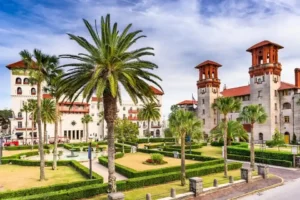
Interesting facts about Florida that highlight its unique character and history:
- Ponce de Leon and the Fountain of Youth: Florida is linked to the legendary Spanish explorer Juan Ponce de Leon, who is said to have discovered it while searching for the Fountain of Youth in 1513.
- Theme Park Capital: Florida is home to the world-renowned theme parks like Walt Disney World Resort, Universal Studios, and SeaWorld, making it a mecca for family vacations and entertainment enthusiasts.
- Everglades National Park: The Everglades is the largest subtropical wilderness in the United States and is home to a unique ecosystem with rare and endangered species such as the American crocodile and West Indian manatee.
- Space Exploration: Cape Canaveral, located on Florida’s Space Coast, is America’s premier space launch site. It has been the starting point for historic space missions by NASA, including the Apollo moon missions and Space Shuttle launches.
- Conch Republic: In 1982, Key West humorously declared itself the “Conch Republic” in protest of a U.S. Border Patrol checkpoint and continues to celebrate its quirky independence with an annual festival.
- Florida Keys: The Florida Keys are a chain of tropical islands stretching about 120 miles off the southern tip of Florida. They are known for their stunning coral reefs, fishing opportunities, and laid-back island lifestyle.
- Spanish Influence: Florida has a strong Spanish heritage due to its colonization in the 16th century. Cities like St. Augustine, founded in 1565, boast historic landmarks such as the Castillo de San Marcos, a 17th-century fortress.
- Art Deco in Miami: Miami’s South Beach is famous for its vibrant Art Deco architecture, characterized by pastel colors, geometric shapes, and neon lights, dating back to the 1920s and 1930s.
- Manatees and Wildlife: Florida is one of the few places where you can encounter manatees, also known as sea cows, in their natural habitat. Manatee sanctuaries and warm springs offer opportunities for up-close encounters.
- Golf Paradise: With over 1,250 golf courses, Florida is a golfer’s paradise. The state hosts prestigious tournaments and boasts courses designed by golf legends like Arnold Palmer and Jack Nicklaus.
Famous cuisine of Florida:
Flavors in Florida’s food reflect the state’s rich cultural diversity, which includes Native American, Spanish, Caribbean, and Southern influences. Here are a few well-known recipes that highlight the flavors of Florida:
- Key Lime Pie: Perhaps the most iconic dessert associated with Florida, Key Lime Pie features a tangy filling made from Key lime juice (smaller and more tart than regular limes) in a graham cracker crust, topped with whipped cream or meringue.
- Cuban Sandwich: Originating from the Cuban immigrant community in Tampa, the Cuban Sandwich is a hearty combination of roasted pork, ham, Swiss cheese, pickles, and mustard, pressed between Cuban bread and grilled until crispy.
- Stone Crab Claws: Florida is famous for its stone crab season, during which sweet and tender stone crab claws are harvested, cooked, and served chilled with a mustard dipping sauce. These crabs are known for their sustainability, as only the claws are harvested and the crabs are returned to the water.
- Gator Bites: Alligator meat is a unique delicacy in Florida, often served as fried “gator bites” or grilled steaks. It has a mild flavor and a texture similar to chicken or pork.
- Florida Orange Juice: Known worldwide for its citrus fruits, especially oranges, Florida produces some of the juiciest and sweetest oranges. Freshly squeezed Florida orange juice is a staple breakfast beverage and a refreshing treat year-round.
- Seafood Platters: With its extensive coastline, Florida offers a bounty of fresh seafood. Popular dishes include grouper sandwiches, shrimp scampi, grilled mahi-mahi, and fried oysters, often served with sides like hush puppies or coleslaw.
- Conch Fritters: Found primarily in the Florida Keys, conch fritters are crispy fritters made from minced conch meat (a large sea snail), mixed with peppers, onions, and seasonings, then deep-fried until golden brown.
- Floribbean Cuisine: Reflecting the fusion of Florida and Caribbean flavors, Floribbean cuisine blends tropical fruits, seafood, and spices. Dishes may include jerk chicken, mango salsa, coconut rice, and plantains.
- Grouper Sandwich: A beloved Florida staple, the grouper sandwich features lightly fried or grilled grouper fillets served on a bun with lettuce, tomato, and tartar sauce. It’s a quintessential choice for seafood lovers.
- Ceviche: A refreshing and citrusy dish, ceviche is made from fresh seafood (often shrimp, fish, or scallops) marinated in lime or lemon juice with onions, tomatoes, cilantro, and sometimes avocado. It’s popular in coastal areas like Miami and Key West.
(FAQs) about Florida:
Q: What is the best time to visit Florida?
- Your preferences will determine the ideal time of year to visit Florida. Winter (December to February) is the best season for beachgoers and theme park visitors because of its moderate temperatures and low humidity. Though they might be hot and muggy, summers (June to August) are popular with people looking for water sports and a lively atmosphere.
Q: Do I need a visa to visit Florida from another state in the U.S.?
- No, as Florida is a state inside the union, citizens of the union do not require a visa in order to enter from another state. However, depending on their place of origin, foreign tourists will require the proper travel documents.
Q: What are the must-see attractions in Florida?
- There are numerous attractions in Florida to satisfy any interest. Disney World Resort, Universal Studios, Kennedy Space Center, Everglades National Park, Miami’s South Beach, Key West, and St. Augustine are a few of the attractions that simply must be seen.
Q: How is the weather in Florida throughout the year?
- Florida often has hot, muggy summers and mild winters due to its tropical environment. Sea winds make coastal regions somewhat colder. When coming during the Atlantic hurricane season, which runs from June to November, it’s wise to keep an eye on the weather forecast. Hurricanes can occur during this time.
Q: What outdoor activities can I enjoy in Florida?
- Florida’s varied terrain provides a wide range of outdoor pursuits. The state offers world-class golf courses, kayaking in rivers and springs, hiking and birdwatching in the Everglades, diving, snorkeling, and swimming in the pristine seas of the Florida Keys.
Q: Is it safe to swim in the ocean in Florida?
- Yes, swimming in Florida’s ocean is usually safe, especially at authorized beaches where lifeguards are on duty. But it’s crucial to heed cautions about rip currents and marine life, including stingrays and jellyfish.
Q: What are some unique cultural experiences in Florida?
- Florida’s historic monuments, food, and festivals all showcase the state’s multiculturalism. Travelers can take in multicultural arts and entertainment in Sarasota and Orlando, discover the Spanish colonial heritage of St. Augustine, experience Cuban culture in Miami’s Little Havana, and go to the Gasparilla Pirate Festival in Tampa.
Q: Where can I find the best seafood in Florida?
- Fresh seafood is highly acclaimed in Florida, particularly in the coastal regions. Seafood restaurants in Key West, Miami, and Tampa Bay are well-known for serving up delicacies like conch fritters, shrimp scampi, grouper sandwiches, and stone crab claws.
Q: What are some family-friendly activities in Florida?
- Theme parks like Legoland Florida, Universal Studios, and Walt Disney World Resort are enjoyable for families. Visits to zoos and aquariums, interactive museums (such as the Museum of Science & Industry in Tampa), and outdoor festivals and events are some more family-friendly activities.
Q: Are there any eco-friendly activities in Florida?
- Sure, there are lots of environmentally friendly things to do in Florida. For example, you can go on eco-tours in the Everglades to see animals like manatees and alligators, visit eco-lodges and nature reserves, snorkel or dive in the coral reefs off the Florida Keys, and explore state parks and wildlife refuges.

